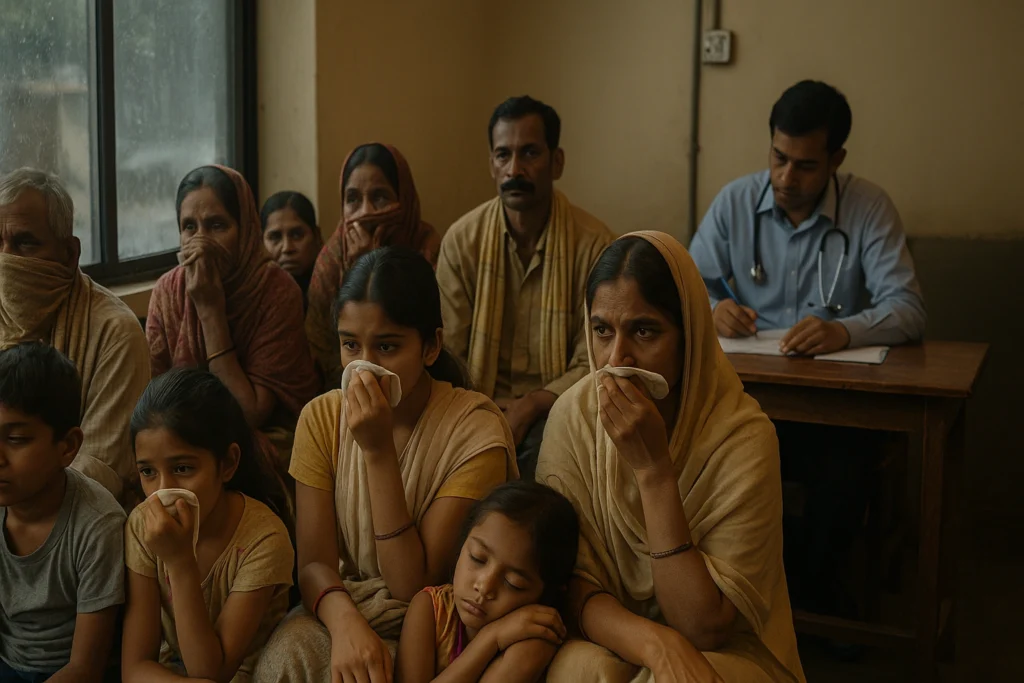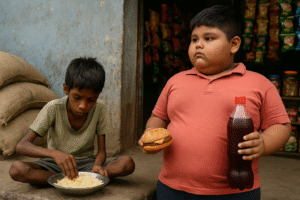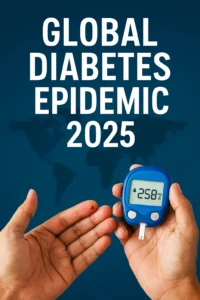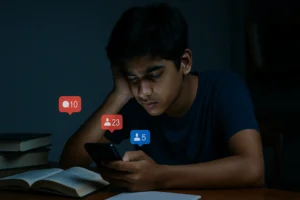Why Monsoon Viral Fever in India Keeps Coming Back—And What We’re Still Not Doing About It

“Monsoon season in India brings a sharp rise in viral fevers, overwhelming small clinics and exposing gaps in primary healthcare infrastructure.”
By Somya Prabhat | newslyy.com
Monsoon viral fever in India isn’t new. It’s almost expected. Every year, as rain clouds take over the skies from Mumbai to Kolkata, something else starts to spread alongside: fever, chills, sore throats, aching joints, and worried families scrambling for a clinic slot. It’s seasonal, yes. But that doesn’t mean it should be normal. Despite increased awareness, monsoon viral fever in India continues to surge year after year. The recurring pattern highlights deeper systemic issues—ranging from poor sanitation to delayed medical response. With every monsoon season, hospitals witness a sharp rise in patients affected by monsoon viral fever in India, yet the country still lacks a cohesive prevention strategy.
In fact, what’s “normal” about thousands of people lining up outside crowded government hospitals? Or local clinics overflowing with patients who can’t tell if it’s just the flu—or something worse?
Let’s talk about what’s really happening. And more importantly, why India still doesn’t seem ready for it.
Table of Contents
Same Season, Same Symptoms, Same Mistakes
Every June, India enters a familiar cycle: the skies open up, and not long after, viral fevers rise. You’ve likely seen it in your own home or neighborhood. Someone develops a fever, then another, and suddenly it’s everywhere.
Doctors call it “viral syndrome.” But often, it’s a placeholder. Because here’s the truth: monsoon viral fever in India is rarely just one thing. It could be dengue. It could be leptospirosis. It could be a waterborne bacterial infection from that leaking municipal tap no one’s fixed for years.
And yet, most cases get treated the same way: rest, paracetamol, fluids, and wait it out.
Why Fevers Flourish in the Rain
The science is simple, yet overlooked. Monsoon brings standing water, humid air, and poor drainage—all ideal breeding grounds for mosquitoes, bacteria, and viruses. When the environment becomes a petri dish, infections flourish.
Cities like Delhi, Patna, and Guwahati routinely report sharp spikes in outpatient visits. According to the National Centre for Disease Control (NCDC), seasonal fevers increase by as much as 40% during peak monsoon months in India’s urban regions. But that’s just what gets reported.
Much of rural India doesn’t make it into the data. Why? Because people often don’t even go to a clinic unless it’s severe—or unless a child gets sick.The rise of monsoon viral fever in India is closely linked to stagnant water, mosquito breeding, and sudden drops in temperature during the rainy season. These conditions create the perfect storm for viruses to spread rapidly, especially in densely populated areas. As a result, monsoon viral fever in India has become a recurring seasonal health challenge.
Diagnosing in the Dark
Here’s a question worth asking: why is it so hard to get a clear diagnosis?
The answer lies in access and infrastructure. In too many parts of India, especially outside big cities, primary healthcare centers lack the tools to test for dengue, typhoid, or chikungunya. Doctors rely on symptoms and best guesses. That’s dangerous. A high fever treated as “viral” might mask something more serious. And delays in identifying that can cost lives.
One general physician in Bhopal told me last year, “We see 30–40 patients a day with fever during monsoon. Only 10% can afford tests. The rest just want the fever to go away.”
But that quick-fix mindset—by necessity, not choice—costs more in the long run.
When the System Only Reacts, Everyone Pays
It’s not that India doesn’t know this happens. We do. We’ve known for decades that monsoon brings illness. And yet, the public health response feels like déjà vu: no early warnings, no sanitation drives until it’s too late, and posters put up after the spike begins.
Compare that with a place like Sri Lanka, where fever surveillance is active during monsoon. Community health workers go door-to-door. Mobile clinics are deployed in flood-prone areas. Public radio and SMS alerts help people recognize dangerous symptoms early.
India has the resources. What we’re missing is a proactive plan.
You may also like India Clean Energy Surge: Bold Moves Toward a Greener Future.
Digital Health: A Missed Opportunity?
During COVID-19, India showed it could move fast with digital tools. Apps like Aarogya Setu reached millions. Telemedicine became mainstream. So why can’t that energy be redirected to seasonal illnesses?
A government-backed fever tracker, localized alerts, or even WhatsApp-based health tips could help families act early. But outside of private platforms like Practo or 1mg, there’s little public-facing innovation.
And what about rural India, where internet access is patchy and mobile literacy low? That’s where radio, community leaders, and ASHA workers could play a bigger role. But only if they’re trained, supported, and listened to.
Who Bears the Real Cost?
Let’s be honest—when systems fail, people improvise. Mothers become doctors. Google becomes a diagnostic tool. And treatment becomes a gamble.
The cost is steep. Missed workdays, hospital bills, kids missing school. For a daily wage earner, three days of fever can mean no food on the table. For a senior citizen with diabetes, it can turn into a hospital stay.
The invisible cost of monsoon viral fever in India isn’t just medical—it’s economic, emotional, and generational.
Where We Can Actually Start
Solving this isn’t rocket science. But it does require intention. Here’s what would help:
- Early education campaigns: Start before the rains, not after. Use local languages.
- Strengthening PHCs: Equip them with basic fever panels, and train staff in symptom triage.
- Community surveillance: Use local workers to log symptoms, spot patterns early.
- Sanitation drives: Before the first storm, not after the flood.
- Digital inclusion: Use SMS, not just apps. Don’t forget those offline.
Because what good is a “Digital India” if it can’t warn someone with a basic mobile phone about a dangerous viral outbreak?
Also check (WHO on monsoon and floods)
Conclusion: Fixing Fevers Is About Fixing Focus
Monsoon viral fever in India will come again next year. And the year after that. But whether it arrives as a manageable challenge or a public health emergency is up to us.
We can’t control the rain. But we can control how we prepare for it.
It starts with admitting that these fevers aren’t seasonal quirks—they’re systemic signals. And until we start listening, the cycle will continue: clouds gather, drains clog, fevers rise, and families suffer.
Unless, of course, we decide to do something different.





1 thought on “Why Monsoon Viral Fever in India Keeps Coming Back—And What We’re Still Not Doing About It”